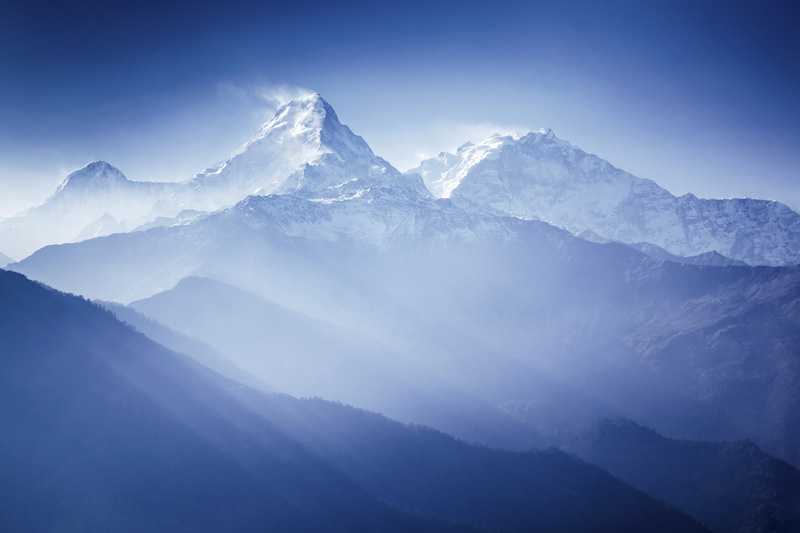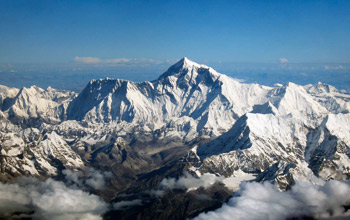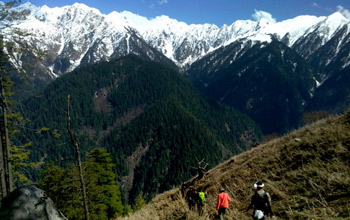About the Great Himalayas
The Great Himalayas are a beautiful mountain range in the Himalayas. The mean altitude of the Great Himalayas Mountain Range is approximately 6,000 meters. Some of the tallest summits in the world are situated in this range, for instance, Nanga Parbat (8126 meters). The Nanga Parbat is the ninth tallest peak in the world and the second tallest peak in Pakistan. As the mountains are eternally coated with snow, there are a number of glaciers in the region. The most extensive glacier is the Rupal Glacier and the length of the glacier is 17.6 km. The glacial activities are responsible for forming a number of picturesque lakes such as the Saiful Muluk Lake. This lake is situated in the higher Kaghan Basin. One more important geological characteristic of this region is the deep canyons formed by the Indus in this area. The deepest canyon is situated at Dasu-Patan area in Kohistan district. The depth of the canyon is 6,500 meters. Actually, this is the deepest canyon in the world. The depth is so profound, that even if that the tallest peak of Europe, Antarctica or North America were to be put at its deepest tip, the mountain would still not jut out further than the pinnacle.
The Greater Himalayas are home to some of the tallest peaks in the world. To the north of the major middle thrust, the tallest mountain ranges ascend suddenly to the extent of 4,000 meters or 13,000 feet into the territory of everlasting frost and snow. Since the Himalayan Mountain Range gets broader from east to west, the count of similar tall mountain ranges goes up. For instance, the Kanjiroba and Kagmara ranges both attain elevations of more than 6,000 meters (20,000 feet), situated to the north of the Dhaulagiri Himalaya in the middle of Nepal.
Montane shrublands and grasslands develop over timberline. You will see the northwestern Himalayan Alpine Shrub and meadows in the upper heights of Jammu and Kashmir , North Pakistan, and Himachal Pradesh . Towards the east, the Western Himalayan alpine shrub and meadows encompass long areas beside the boundary of Tibet with west Nepal and Uttaranchal . The Eastern Himalayan Alpine Shrubs and meadows develop over the eastern and northeastern subalpine coniferous jungles adjoining the boundary of Tibet with Sikkim, eastern Nepal, Arunachal Pradesh and Bhutan. The bushlands consist of junipers and a comprehensive range of rhododendrons. The forests are also home to a wonderful array of wild flowers. The Valley of Flowers National Park in the western Himalayan alpine shrub and meadows houses hundreds of categories. The higher edge of the lowlands grows from the west to east, ascending from 3,500 meters (11,500 feet) to 5,500 meters (18,000 feet). The lowlands are the summertime dwelling place of the imperiled snow leopard (uncia uncia).
f the most significant and tallest peaks of the mountain range are Mount Everest, K2, Lhotse, Kanchenjunga, Cho Oyu, Makalu, Manaslu, Dhaulagiri, Nanga Parbat and Annapurna.
Mount Everest
This is the tallest peak in the world with a grand elevation of 29,029 ft (8,848 m) above sea surface. The peak is known in various names as it is also termed as Qomolangma in Tibet and Sagarmatha in Nepal. Nevertheless, the mountain was named after Sir George Everest who was the British Surveyor General of India. The mountain lies on the borders of Nepal, India, and Tibet.
Karakoram (K2)
Karakoram or K2 was initially discovered by a British photographer and voyager, Henry Godwin-Austen and the peak was named after his name as well. It has the position of the second tallest peak in the world with an elevation of 8,611 m (28,250 ft) above sea level. The peak is also named as “Chogo Ri”, which plainly denotes the “Great Mountains.”
Kanchenjunga
The Kanchenjungha is the third tallest peak in the world with an elevation of 8,586 m (28,169 ft) above sea level. In spite of the fact that it has the third position, it has still stayed uncultivated. A number of mountaineers and hikers believed as it is riskier than Mt. Everest and other peaks to discover it.
Lhotse
Lhotse is the fourth tallest peak of the range. The peak has a height of 8,516 m and is situated close to the southern fringes of Mount Everest.
Makalu
Makalu is the fifth tallest peak of the world. The peak has an elevation of 8,463 m above sea level. It is situated in Tibet.
Cho Oyu
With an elevation of 8,201 m above sea level, Cho Oyu holds the position of the sixth tallest peak of the world. It is situated in Tibet around 28 km away from Mount Everest.
Dhaulgiri
The Dhaulgiri peak is situated on the boundary of Tibet and Nepal and it ascends 8,167 m above sea level. It's the seventh tallest peak in the world which is endowed with several steep edges, icefalls, and glaciers.
Manaslu
Manaslu is the 8th tallest peak in the world. The peak has an elevation of 8,156 m above sea level. In Sanskrit language, Manaslu stands for “Mountain of the Spirit”.
Nangaparbat
It is the ninth tallest peak in the world. With an elevation of 8,126 m (26,660 ft) above sea level, the peak is always risky to discover because of its steep ridges. There were a number of disasters related to this peak when mountaineers attempted to climb it.
Annapurna
With an elevation of 8,091 m, Annapurna is the 10th tallest peak in the world. The mountain also consists of five other peaks in the area and houses numerous glaciers.
The Great Himalayan National Park
The Great Himalayan National Park is situated in the higher ranges of the Himalayan Mountain Range in Himachal Pradesh, India. The national park features an exotic blend of alpine flora and fauna. The exceptional features of the park are not to be seen anywhere else in the country. A significant portion of the park stays perpetually under snow and glaciers. The Great Himalayan National Park is one of the ultimate bionetworks in the Western Himalayas, offering refuge to a wide variety of flora and fauna. The biodiversity of the park makes it a charming tourist spot in this region of India. The national park is also named as the Jawaharlal Nehru National Park. It got the status of a national park in 1984 in order to protect the imperiled species of wildlife in the Himalayas. You will see more than 30 species of animals and 200 species of birds in this park. The diversified fauna and avifauna of this prestigious national park include the following:
- Snow Leopard
- Leopard
- Brown Bear
- Serow
- Bharal
- Thar
- Langurs
- Ghoral
- Musk Deer
Avifauna
You will get to see the following varieties of birds in this region:
- Tragopan
- Cheer
- Khalij
- Monal
This national park is located in the Kullu District of Himachal Pradesh. You can take part in a number of popular adventure sports and activities in this region such as rock climbing, hiking, hang-gliding, and skiing. All the important tourist attractions like Haridwar, Rishikesh, and Dehradun are closely located to this park.
The trail of the Great Himalayas is referred to as the Holy Grail by the trekkers and mountaineers. The range is one of the very few remote and almost unreachable territories in the world at the present time. The range is home to some of the tallest peaks in the world, including Annapurna, Nanga Parbat, Kanchenjungha, and Mount Everest.



